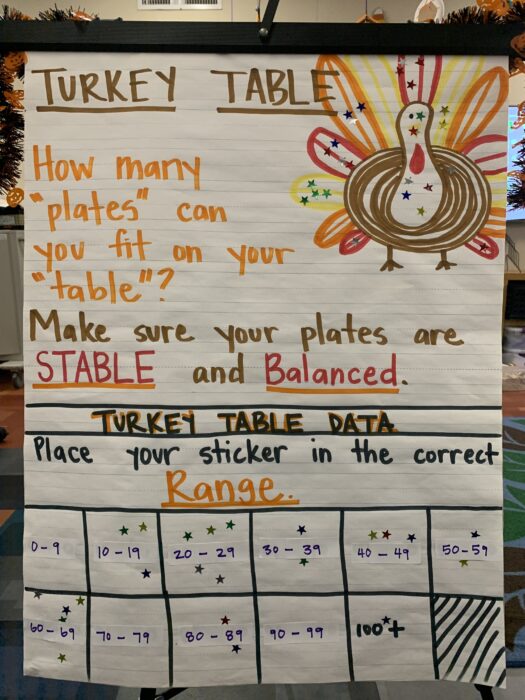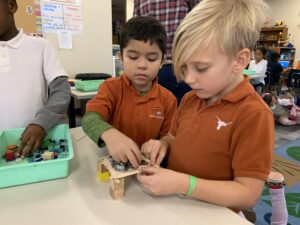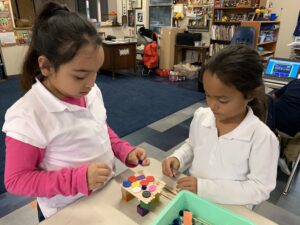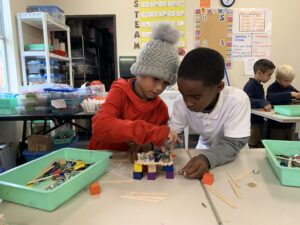Over the past 10 years, schools have started including the STEAM learning model into their schools. STEAM is an acronym for Science, Technology Engineering, Art and Math; but outside the school walls, most people do not really understand why or how it is implemented within the student’s day. We spent an afternoon with Mrs. Calvin, UTES’s STEAM teacher to learn more. This is Mrs. Calvin’s 3rd year teaching STEAM after specializing in 4th and 5th grade science at UTES for 4 years. She was a member of the Urban Specialization Cohort of The University of Texas College of Education in 2012 as well as a 4 year member of the Texas Regional Science Collaborative, both of which she attributes as the most effective tools for preparing her to provide relevant, rigorous, and real opportunities for students to thrive in STEAM.
In typical schools, there are specific skills related to the core classes (English Language Arts, Math, Science and Social Studies) that students are required to learn and it is those skills that are measured through state testing. Usually, these subjects are taught within a silo and how they are interconnected may become lost. STEAM classrooms have more flexibility and time, which naturally allow students to make connections between skills they are required to learn and real-world situations where they are applicable. STEAM classrooms heavily incorporate critical thinking skills, allow more independence and collaboration and help students answer the age-old question: “How am I going to use this in real life?”
STEAM in action – Turkey Table
Just in time for Thanksgiving, this is a STEAM lesson that Mrs. Calvin was using in her class on the day of our visit. First grade students, in pairs or alone, made “tables” using cubes and popsicle sticks. When tables were ready, the objective was to place as many “plates” on top before it collapsed. Materials for plates included flat marbles, metal washers, and nuts. Students were encouraged to place and stack items freely to test and reflect. When their structure fell, students counted plates with the goal of making another table and adding more plates than the first time. This approach incorporated the engineering process fluidly in a setting appropriate for young learners and provided an opportunity for reflection and growth. In her projects for all grades, Mrs. Calvin encourages students not to focus on their final numbers, but the growth they are able to attain while tending to a given task.
As Mrs. Calvin checked in with each building team, she reiterated engineering terminology such as: “stable and balanced” so the students would understand the words in context. When it came time to count the plates, students would work on invented methods of mathematical fluency (1:1 correspondence, skip counting, subitizing) and scientific grouping (classification with understanding physical properties) and Mrs. Calvin provided differentiated support as needed. When students rebuilt their structures, they would learn from their mistakes and make their structures stronger or larger (testing variables) to hold more plates. This process naturally allowed students to self-assess their learning, set goals for higher achievement as well as provided justification for their choices in material and design. These types of lessons integrate state skills but also incorporate abilities and desires of students to explore and take control of their learning in context, all while problem solving in a collaborative group.
Providing hands-on activities for students to learn and practice skills in the classroom, then applying them in a STEAM setting in ways that empower them is cornerstone to Mrs. Calvin’s philosophy of student achievement. She said, “It is crucial to provide opportunities for students to develop necessary executive functions such as problem solving, organization, collaboration, communications, and time management at younger ages. These skills are essential for success in adulthood. In core classrooms, state testing is heavily emphasized and prioritized. It is imperative that students, and core teachers alike, feel supported in creating a space for students to enrich and apply skills learned as students may or may not have the opportunity or resources to do so outside of the school setting. This awareness, distinction, and prioritization is what sets UTES apart from others.”
Most schools do not have a stand-alone STEAM class like UT Elementary School built into their school day for students in grades Prekindergarten through fifth grade. STEAM classes are not required but they do ultimately better-serve the students. At The University of Texas Elementary School, our teachers and leaders believe in the academic benefits of STEAM education for our students. We are dedicated to keeping our students enriched with STEAM to help them make connections, set goals, and be proud of their contributions because ultimately, what starts here changes the world.



To learn more, visit Ms. Calvin’s class page at: https://utsteam.wordpress.com/



